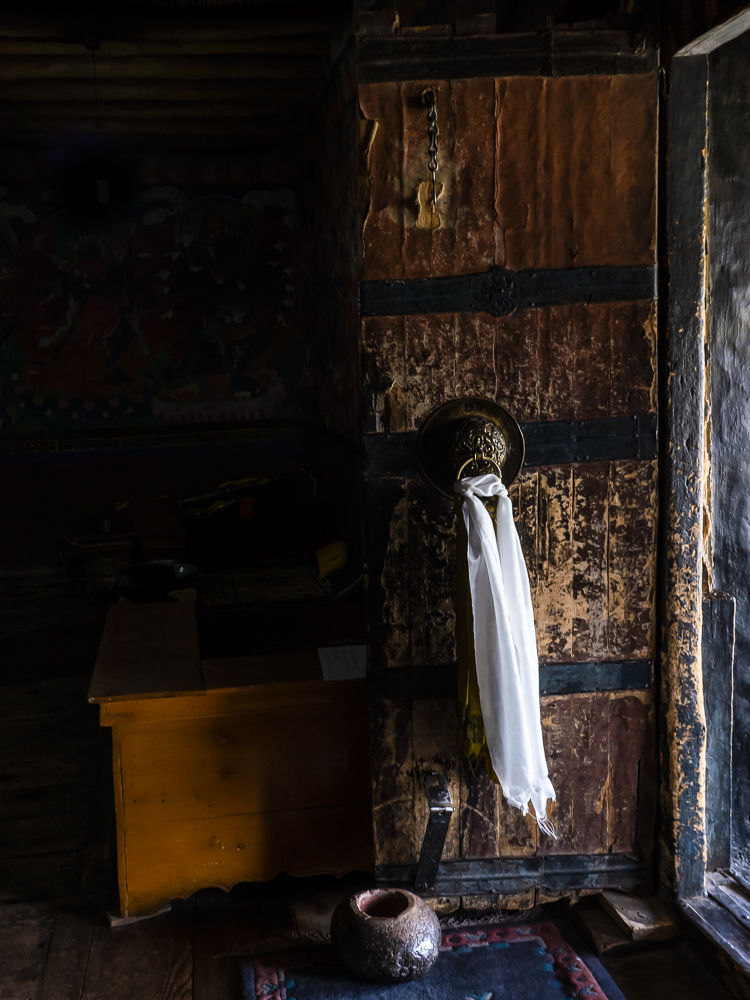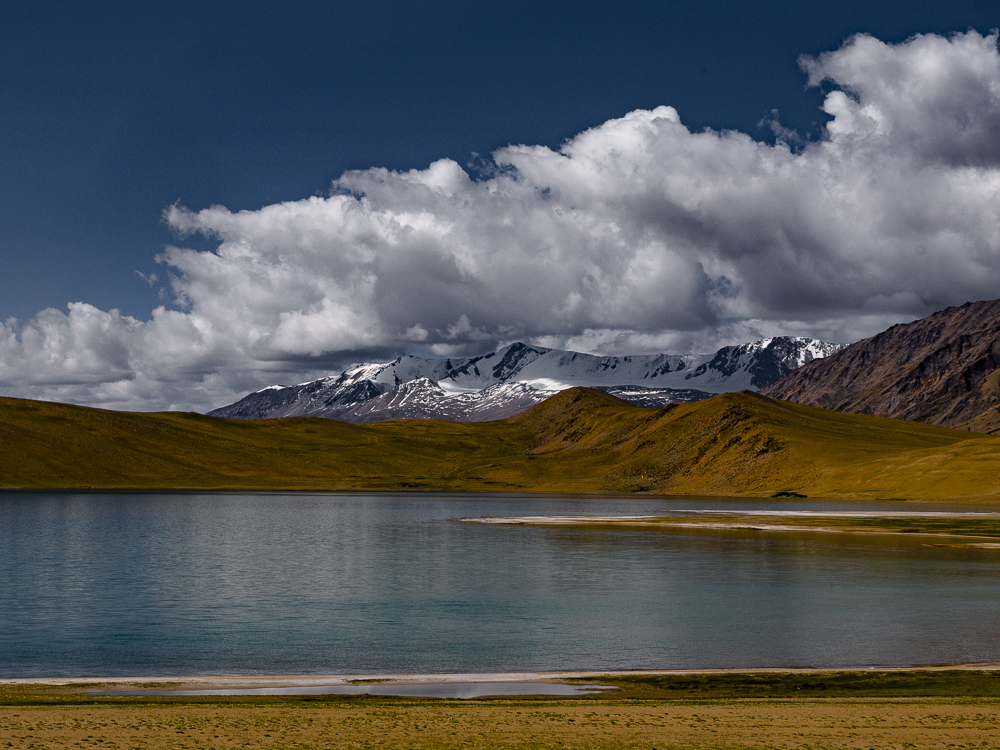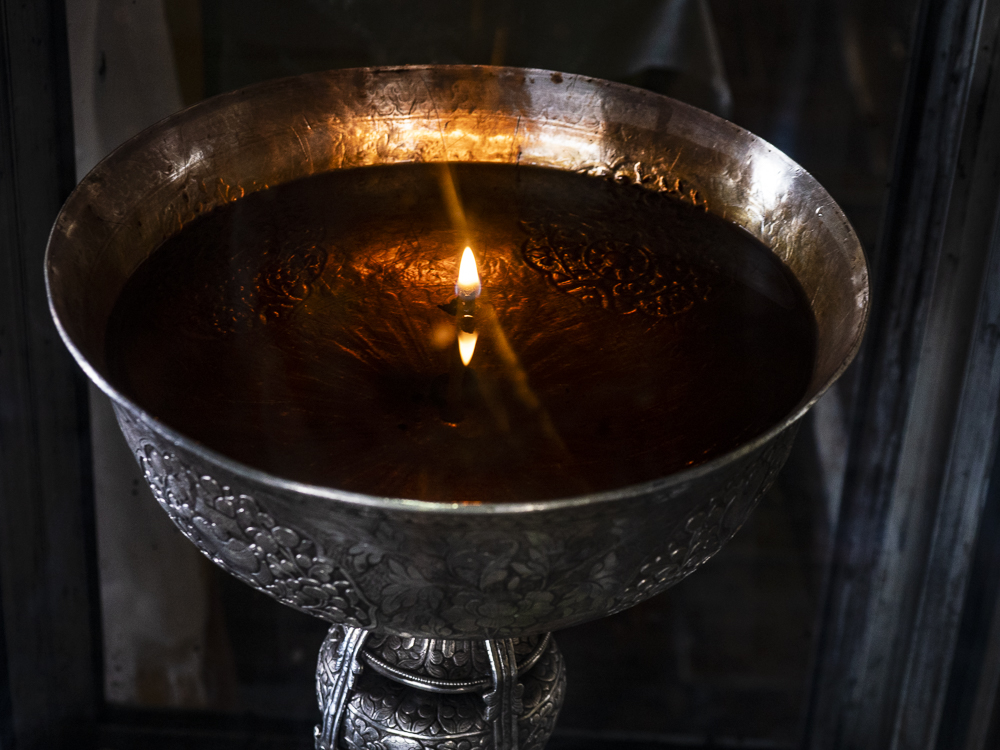PHOTOGRAPHY AS PRAYER
or:
Nyitse – the Time when Sunrays Paint the Mountains Red
In a little bookshop in Leh, the owner tells us that the distinguished-looking man who just left the shop is the Ladakhi writer Abdul Ghani Sheikh. Feeling as though we almost met the writer, my friend Doreen and I immediately purchase a copy of Forsaking Paradise – Stories from Ladakh, (1) to read on our travels in Ladakh - the country of High Passes.
“A True Portrait”, the first story in the book tells of an American tourist, eagerly photographing an old Ladakhi man who is spinning his prayer wheel and chanting mantras. The tourist explains to his guide:
“He looks like a life s+6pecimen of ancient Ladakh and a true representative of the culture (…) Since Tibet became a prohibited area, we come to Ladakh to experience Tibetan culture and Buddhism. But all we see here is young people in jeans and jackets. I fear the culture of this place will be totally erased in a few years. In our country too, the Indians are losing their culture” (2)
These patronizing words, crowned by the reference to American Indians, make one ask if the tourist’s concern for the vanishing cultures is genuine, if he is apprehensive for the sake of the Ladakhis, or, for that matter, the American Indians. Or, does he decry the erasure of traditional cultures because it deprives him of the opportunity to capture the ‘authentic’ – encountering only young Ladakhis in jeans; because it would stop him from bringing home a heroic trophy he shot on his photographic safari – to use the well-known parallel between photography and hunting drawn by Susan Sontag. (3)
A very different perspective is presented by Helena Norberg-Hodge in Ancient Futures – Learning from Ladakh (4) another book we picked up at the same bookstore in Leh. Norberg-Hodge is also concerned with a vanishing way of life of the Ladkhis, but much more for the sake of the local people themselves. This veteran researcher in Ladakh – turned activist for a more sustainable mode of development - laments the loss of the Ladakhis’ sense of dignity and independence, as cash market forces penetrate their subsistence economy.
I often ask myself, as a photographer traveling to remote places, do I fall into the same trap as the tourist in Ghani Sheik’s story, do I seek out the ‘authentic’ so that I too have trophies to post on facebook, to put on my website, to show in an art exhibit?
One way in which I try to solve some of the problematics of intrusion and cultural superiority exemplified in the Ghani Sheikh story, is that I seldom permit myself to photograph people, certainly not without their consent – for fear of intruding, as a privileged tourist from the West who has the power and resources to come and go.
In fact, years ago, as a graduate student of anthropology, I decided to leave the discipline - and academia - precisely because I questioned the right of the researcher, the participant observer, to impose herself on the lives of less privileged others, turning them into objects of study.
*
In Ladakh, Doreen and I precede our planned trek with an excursion by car in order to reach more distant landscapes and monasteries. After we are well acclimatized to the altitude of Leh at 3,500 meters, our driver takes us over a 5,350-meter pass into the beautiful Nubra valley. A few days later, after a very long drive, we reach the Tso Moriri Lake, lying at the high altitude of 4,500 meters. We plan our arrival in time for the annual festival at the Korzok monastery the following day, where monks, wearing costumes and masks, dance, enacting the ritual battle between good and evil.
Despite the distance from Leh, there are quite a few other tourists who attend the festival, almost all equipped with their cameras – be it cell phones, point-and-shoot cameras or various degrees of more professional equipment. Even so, the tourists are in the minority and it is clearly still a religious ceremony for the monks and for the villagers, clad in their colorful traditional clothes. A handful of elderly village women are still wearing the perak headdress that parades their collection of treasured turquoise stones, but the number who do so diminishes by the year.
How much longer will such festivals be held as a celebration by the monks and the local population, until are changed by the very photographers who want to preserve it as ‘authentic’, and they become a spectacle performed only for the tourists?
A few days before the Korzok festival, at the dunes and wetlands in the Nubra Valley, we catch a group of photographers in action, all with long tele-lenses, as they take photos of a Ladakhi archer who is posing for them in traditional garb, stretching his large, elaborately curved bow. Naturally, I take photos of the telling, rather humorous scene. It turns out, the same group, on an organized photography tour led by a British and an Indian photographer, is also taking pictures at the Korzok festival. At least that is not staged.
Of course, at Korzok, I am photographing the dancers, together with all the other photographers, in an attempt to capture the essence of the festival - the dancers in a swirl, their costumes flaring wide; the musicians drumming, blowing their trumpets; the ceremonial gestures of the monks. And to convey the entire setting - with snow mountains in the distance, the audience that fills the spaces on the balcony, the roof with patterns of color. I even take a few photos with my cellphone, to post on facebook, as soon as we get to a place where there is Wi-Fi. Carried away, I am a part of the tourist ritual.
But in the late afternoon, at the lake, I am alone with the landscape – even when other tourists come to photograph at the same overlook, I am one with the lake. I watch the darkening shadows and the utterly still waters, mirroring the snow mountains across the lake, perhaps already in Tibet. Here I am not documenting a scene. It is surrender of the spirit, a meditation.
The day before, when we first reached the tip of the elongated lake, Doreen and I asked our driver to meet us further up the road towards the village, and we walked along the shore to witness the magic of the lake. It seemed like a living body, its colors changing when the wind blows or the sun shines or disappears behind the clouds, moving from blues to greens and greys and even almost black. It is to breathe in the sublime.
Perhaps that is why I am first and foremost, a nature photographer, in an effort to avoid the pitfalls of privilege and cultural superiority. Especially in my preferred mode of travel which is trekking, because it allows me to immerse myself in the landscape, to be a part of it while experiencing its subtle changes - rather than visiting the ‘sights’ that have been singled out as tourist attractions, where you stand above it all. And if I do reach such noteworthy places on my trek – be they cultural or natural – I will have gotten there on foot, as part of a process of gradual unveiling, a preparation of the spirit. And so they happen as a kind of slow discovery, or even a climactic revelation.
I only regret that we were not able to chance upon the Korzok festival after a long and arduous trek.
*
The little trek we do in Ladakh takes us through dramatic desert landscapes – with green only in the valleys watered by streams from melting snow. We choose a relatively easy route, from Likir to Temisgang, with passes that do not exceed 3,800 meters – for at the ages of 72 and Doreen’s almost 82, we are not sure we can climb much higher anymore. Still, each pass, whether low or high, is marked by cairns or chortens with strings of flags sending out their prayers into the wind. It gives a sense of accomplishment, to reach these traditional milestones.
On the first day of our trek, after crossing a wildly colored desert landscape, with snow-mountains of the Zanskar range in the distance, we approach the little village of Yangthang, where we run into preparations for an archery festival that is to take place the following day. As we are in no rush and the point of our trek is immersion in the landscape and local culture, we stay an extra day. In contrast to our trip visit to Korzok, which was planned to coincide with the festival at the monastery, the archery festival in Yangthang is a much more serendipitous experience.
Rather than being observers among an army of photographing tourists, we are virtually the only visitors and are graciously invited to join in the dances, and to partake of the free-flowing barley beer, or chang, which is generously poured into our glasses. Tsomo, the young woman at whose house we are staying, takes to Doreen who reminds her of her own grandmother, and brings her a traditional costume to wear, so that Doreen becomes even more a part of the festivities. Here, it does not feel intrusive to photograph, as we seem to be warmly accepted by the community.
Homestay accommodations on our trek enable us to spend time with the family, to witness their daily life – as they act out their morning rituals of lighting incense and butter lamps; milk the cow and collect her dung to dry in the sun; play with the little toddler still at home; pick vegetables from their garden.
Staying with the family allows us to get closer to the people, so that I even venture into portrait photography in the semi-darkness of the family kitchen and sitting room. It is said that many people in the Third World do not want to be photographed, for fear their preserved image will take away something of their soul, of their life-force. Indeed, photography reifies the passing, quivering moment, holds it still, while life goes on. Perhaps that is a kind of killing.
As I photograph, it is only intuitively that I feel the chiaroscuro quality of the light allows those portraits to transcend the moment.
*
During our three weeks in Ladakh, we visit a total of eighteen Tibetan Buddhist monasteries and nunneries. Each has its own distinctive aura, with its delicate frescos and thangkas hanging on the walls; its statues of Buddhas and other venerated figures; its special architectural layout. And all are, in some way or other, enveloped in that soft, diffuse light filtering in from the windows and low entrance door, through cracks in the walls and ceilings, and from the flickering of oil and butter lamps.
Our Ladakhi guide and drivers, who take us into the monasteries, bring their offerings of oil and ghee for the lamps. Upon entering, barefoot, of course, they prostrate themselves three times, very athletically bending to their knees and springing up again, before they begin to circumambulate the space of the sanctuary, always in the clockwise direction, stopping at each statue and sometimes leaving a few rupees.
I want to imitate their movements and gestures that seem such an integral part of the space, such a natural way to enter it, a supple dance to the music of the silence and diffuse light. Instead, I photograph –unless there is a sign outside that forbids photography altogether.
And then it occurs to me, that perhaps photography is my kind of prayer, my way of suspending myself from the mundane, my way of being inside that sacred space. I think of the Hebrew concept of kavannah, translated as devotion, concentration, intention, or orientation of the heart – an attitude necessary for prayer. It is like focusing in photography – to enter the world through the lens, into a different time-space that ties you to what is there, but also sets you apart from the world around you.
Rather than excluding what lies outside the frame and the time that flows onwards, beyond the moment of the shot, the lens allows you to delve deeper into that particular pinpoint of time and space – and to expand it, to make it all encompassing. Then nothing else matters, nothing else exists.
This is what Kurt H. Wolff, my sociology teacher and mentor in my college years, calls ‘surrender’ (5) – a total immersion in the moment, suspending all received notions, all preconceptions – all that is taken for granted. Instead of taking away from the actual, lived experience – of walking in a landscape, of being inside a monastery – the act of photographing can deepen the experience, make it immensely richer.
It is an act of surrender to that special moment, taking a step back from the mundane, to immerse yourself in the “in-between” – in liminal time and space.
I delight in the way Helena Norberg-Hodge, the first western scholar to study the Ladakhi language, describes the special terms for time of the Ladakhi language:
Ladkahi has many lovely words to depict time, all broad and generous. Gongrot means “from after dark till bedtime”; nyitse means literally “sun on the mountain peaks”; and chipe-chirrit, “bird song,” describes that time of the morning, before the sun has risen, when the birds sing. (6)
What struck me about these expressions is that they all refer to a time that is liminal – that is in-between the ordinary, taken for granted hours of the day.
The time of prayer.
Or photography.
***
notes:
1. Abdul Ghani Sheikh -Forsaking Paradise – Stories from Ladakh, Katha, New Delhi, no date
2. Forsaking Paradise – A True Portrait - page 40
3. Susan Sontag – On Photography, Anchor Books, Double Day, NY, 1977
4. Helena Norberg-Hodge, Ancient Futures – Learning from Ladakh – Oxford University Press, New Delhi, 1992
5. Kurth H. Wolff – Surrender and Catch, D.Reidel Publishing Co., Dordrecht, Holland, 1976
6. Ancient Futures, page 35
***
Jerusalem, August 31, 2019























